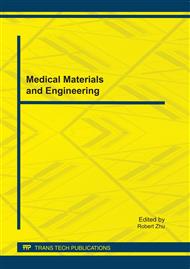[1]
Yunsheng Jiang, Tingting Yan, Zhijun Wang, Development of Fermented Rabbit Ham[J], Culinary Science Journal of Yangzhou University, 2010, 27 (1): 3842.
Google Scholar
[2]
Xianbao Li, Gang Chen, Studies into Proportioning of Strains and Fermentation Conditions of Fermented Rabbit Sausages[J], Food and Fermentation Industries, 2008, 34 (2): 140-144.
Google Scholar
[3]
Casaburi A., Aristoy M.C., Cavella S., et al, Biochemical and Sensory Characteristics of Traditional Fermented Sausages of Vallo di Diano (Southern Italy) as Affected by the Use of Starter Cultures[J], Meat Science, 2007, 76: 259-307.
DOI: 10.1016/j.meatsci.2006.11.011
Google Scholar
[4]
Casaburi A., Monaco R.D., Cavella S., et al, Proteolytic and Lipolytic Starter Cultures and Their Effect on Traditional Fermented Susages Ripening and Sensory Traits[J], Food Microbiology, 2008, 25: 335-347.
DOI: 10.1016/j.fm.2007.10.006
Google Scholar
[5]
Cocolin L., Dolci P., Rantsiou K., et al, Lactic Acid Bacteria Ecology of Three Traditional Fermented Sausages Produced in the North of Italy as Determined by Molecular Methods[J], Meat Science, 2009, 82: 125-132.
DOI: 10.1016/j.meatsci.2009.01.004
Google Scholar
[6]
Huang Juan, Technological Studies on Fermented Mutton Sausages[D], Agricultural University of Hebei, 2004, 6.
Google Scholar
[7]
Ping Shen, Microbiological Experiments[M], Academic Press, 2001: 116-120.
Google Scholar
[8]
Zhai Zhu, Inspection Technology of Pathogenic Microorganism of Food[M], Press of Light Industry, 1987.
Google Scholar
[9]
Like Wu, Study on Acute Toxicity of Probiotics Compound Preparation "Hai Sheng Yuan"[J], Chinese Journal of Microecology, 2003, 15 (4): 202-207.
Google Scholar
[10]
Albano H., Pinho C., Leite D., et al, Evaluation of a Bacteriocin-producing Strain of Pediococcus acidilactici as a Biopreservative for "Alheira", a Fermented Meat Sausage[J], Food Control, 2009, 20: 764-770.
DOI: 10.1016/j.foodcont.2008.09.021
Google Scholar
[11]
Ming Pan, Studies on the Relation between Fermentation Bacterial Colonies of Rubeng Ham and its Quality[D], Yangzhou University, 2007: 25-26.
Google Scholar
[12]
Yongxia Wang, Bacteria Screening of Meat Starter Culture and its Application in sausage fermentation[D], China Agricultural University, 2004, 5.
Google Scholar
[13]
Houle J F, Lafrance M, Selection of Mixed Cultures for Meat Fermentation[J], Journal of Food Science, 1998, 54 (4): 839-842.
DOI: 10.1111/j.1365-2621.1989.tb07894.x
Google Scholar
[14]
Dong Xiuzhu, Cai Miaoying, Systematic Identification Manual of Common Bacteria[M], Science Press, 2001: 289-294.
Google Scholar
[15]
Ling Daiwen, et al. Classificational Identification and Testing Methods of Lactic Acid Bacteria[M], Press of Light Industries, 1999: 117-128.
Google Scholar
[16]
Lee J.Y., Kim C.J., Kunz B, Identification of Lactic Acid Bacteria Isolated from Kimchi and Studies on Their Suitability for Application as Starter Culture in the Production of Fermented Sausages[J], Meat Science, 2006, 72: 437-445.
DOI: 10.1016/j.meatsci.2005.08.013
Google Scholar
[17]
Greco M., Mazzette R., Santis D., et al, Evolution and Identification of Lactic Acid Bacteria Isolated during the Ripening of Sardinian Sausages[J], Meat Science, 2005, 69: 733-739.
DOI: 10.1016/j.meatsci.2004.11.004
Google Scholar
[18]
Rantsiou K., Drosinos E.H., Gialitaki M., et al, Use of Molecular Tools to Characterize Lactobacillus spp. Isolated from Greek Traditional Fermented Sausages[J], International Journal of Food Microbiology, 2006, 112: 215-222.
DOI: 10.1016/j.ijfoodmicro.2006.09.001
Google Scholar
[19]
Drosinos E.H., Paramithiotis S., Kolovos G., et al, Phenotypic and Technological Diversity of Lactic Acid Bacteria and Staphylococci Isolated from Traditionally Fermented Sausages in Southern Greece[J], Food Microbiology, 2007, 24: 260-270.
DOI: 10.1016/j.fm.2006.05.001
Google Scholar
[20]
Urso R., Comi G., Cocolin L, Ecology of Lactic Acid Bacteria in Italian Fermented Sausages: Isolation, Identification and Molecular Characterization[J], Systematic and Applied Microbiology, 2006, 29: 671-680.
DOI: 10.1016/j.syapm.2006.01.012
Google Scholar


